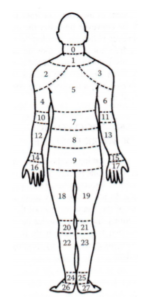5 things you can do to tackle musculoskeletal problems (MSDs) in your business:
Jul 27, 2021

MSD is the most common workplace injury and cause of lost time at work, so spending time to focus on it makes good business sense.
Research has shown that the old approach of teaching a person how to lift correctly has not been effective in reducing these problems. Many workplaces pay to bring various experts into the workplace to help them address MSDs but a lot can be done inhouse by those leading the business.
1. Survey your workers for discomfort pain and injury using a body map:
To start a discussion around MSDs print and hang a poster of a body on a whiteboard or wall
(see body map at the end of this article). Next to the poster, provide a marker or stickers for the workers to use to place crosses on the body parts where they have experienced pain or other MSD symptoms in the past week or month. Each worker can also make a mark at the bottom of the poster to indicate that they have contributed. When there is the same number of marks at the bottom as the number of workers, or it’s been established that everyone who wants to contribute has done so, the patterns that emerge from the poster can be used for a toolbox discussion and brainstorming session.
2. Ask your workers to take photos of things they think contribute to discomfort, pain and injury at work:
Ask workers to take photos using their mobile phones over a two-week period. Each person (workers and managers) should take two or three photos of something that they perceive as risky or that they find triggers MSD symptoms at work. They can also take pictures of work situations or equipment that they perceive as helping to prevent MSDs. The quality of the photos doesn’t matter and they don’t have to be self-explanatory. Ask each worker or manager to provide brief explanations of their photos. To give an example of a photo of a risk, it might show the height of a ladder on a vans roof rack (which requires force and an awkward body position for workers to reach). An example of a picture of something that helps to prevent MSDs might be a photo of colleagues helping each other during a pressured time. Each person can be helped to print out their photos and stick them to a board (e.g. in a lunchroom or meeting room). Once the photo shoot is over, arrange a toolbox talk at which all the photos are on display and the topics raised can be discussed. The aim is to establish a shared understanding of what the photos represent.
3. Think about the physical and mental demands on your workers
There are well-known physical and mental demands of work that lead to MSDs and lower productivity. Identify if you have any of these issues in your business:
- Excessive physical or mental workload: not enough time to do the job, too much work, permanent time pressure, long working hours
- Tasks do not match workers’ skills: they are too difficult or too easy
- Tasks are monotonous and repetitive; workers have no opportunities to feel a sense of ownership of any tasks
- Workers are required to be constantly available, e.g.to respond to emails and phone calls outside working hours
- Many physical risks are present in the workplace, with no preventive measures
Aim to address these demands by:
- Make sure there is enough time to do the job, workload is regularly monitored and extra resources are provided during ‘peak’ times
- Provide tasks that allow workers to make use of and develop their skills and competencies
- Provide tasks that are challenging and interesting; workers feel a sense of ownership of their work
- Respect your workers’ need for a good work-life balance so there is enough time outside work to recover and recharge
- Provide a good physical work environment, with protective measures implemented to tackle risks
4. Where possible get work up off the ground:
Working and handling at ground level places strain on our bodies which overtime can develop into MSDs. Take photos of tasks that require stooping and bending to complete at your workplace. Look for items that are stored on the ground. During toolbox talks discuss ways which the task can be redesigned by raising the work off the ground for example with a trestle, pallets or providing a table. If it can’t be raised, can we extend our tools or modify our position to compensate?
5. Where possible eliminate overhead work:
Jobs that require overhead work are 2 to 3 times more likely to result in a shoulder injury. Overhead work becomes more hazardous when the arms are elevated over 60 degrees. Use a toolbox talk and photos to identify where overhead work is required. Where possible aim to eliminate it and where it must remain look to design alternative ways to complete it. This includes reducing the force required, using lighter and smaller tools, keeping the arm below 60 degrees and using frequent rest breaks.















